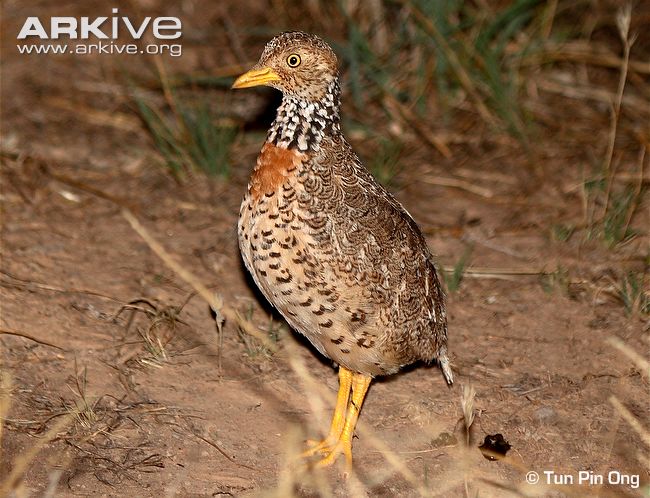
Pedionomus torquatus
SUBFAMILY
Pedionominae
TAXONOMY
Pedionomus torquatus Gould near Adelaide, South Australia.
Traditionally placed with the Turnicidae, but as of 1990s increasingly
recognized as belonging in the Charadriiformes,
family Pedionomidae, and allied with the seedsnipes
(Thinocoridae).
OTHER COMMON NAMES
English: Collared plains-wanderer/hemipode, turkey quail;
French: Pйdionome errant; German: Steppenlдufer; Spanish:
Llanero.
PHYSICAL CHARACTERISTICS
5.9–7.5 in (15–19 cm); male 1.4–2.8 oz (40–80 g), female
1.9–3.4 oz (55–95 g). Buttonquail-like bird with longer legs,
small raised hind toe, shorebird-like mannerisms. Mottled and
scalloped brown, with pale, scalloped underside. Female larger,
with black-and-white mottled collar, reddish upper breast. Juvenile
smaller, with spotted underside.
DISTRIBUTION
Inland eastern Australia.
HABITAT
Sparse native grasslands with low herbaceous layer; rarely in
stubble or sparse low crops.
BEHAVIOR
Terrestrial, diurnal, and solitary except when pairing or when a
male is tending chicks. Sedentary except when forced to move
by drought or changes to habitat. Individuals occupy home
ranges of 17.3–51.9 acres (7–21 hectares). Stands on tiptoe,
with head bobbing, to scan for danger. Roosts solitarily in
grass using the same roost nightly.
FEEDING ECOLOGY AND DIET
Eats seeds and insects obtained by gleaning from the ground
or sometimes the standing heads of grasses. Lives without surface
water but gleans dew and raindrops from vegetation.
REPRODUCTIVE BIOLOGY
Lays in spring and summer in temperate southern parts of its
range, and autumn to early winter in subtropical northern
parts. Possibly sequentially polyandrous. Clutch is usually four
eggs, though up to five. Incubation 23 days. Young are independent
after two months and can breed by one year old.
CONSERVATION STATUS
Classified as Vulnerable, revised to Endangered in 2000 by the
IUCN and listed on Appendix II of CITES. Fairly widespread,
but rare and declining owing to loss of native grasslands to
agriculture.
SIGNIFICANCE TO HUMANS
Rare in aviculture.
Other popular Animals
Photo Gallery of - Plains-wanderer




 Animalia Life
Animalia Life